Check out my latest review of pickleball paddles and my updated ranking of the 6 best pickleball paddles I’ve used. (Hint: You may not yet have heard of paddle newcomer and my No. 1 pick!)
The official sport of retirement communities, adored by senior citizens with hip replacements, has now become my newest obsession.
For some reason, God gifted me with the unusual ability to whack a whiffle ball around a 20′ x 44′ court with absolute precision. And to think how many years I wasted on football, baseball, basketball, volleyball and CrossFit. If only I had been mentored at a young age by a pro, perhaps you would be admiring me on the cover of Pickleball Quarterly.
But alas, I am only destined to be a fleeting phenom in this growing sport due to business and family obligations. However, this year’s county Pickleball Championship trophy looks likely to adorn my mantle.
Since I cannot turn back the clock and excel beyond Ben Johns’ greatness, I will devote my skill to testing the best (and sometimes worst) pickleball paddles. Before you continue reading this review, be sure to read my previous paddle review to learn the secrets behind the paddle industry.
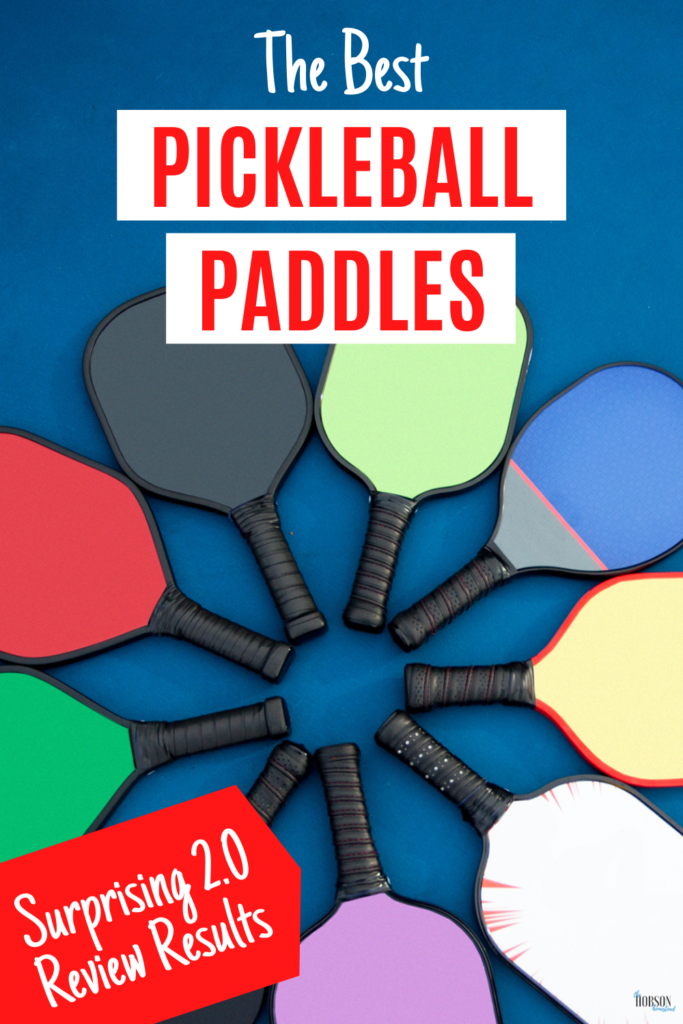
This next batch of pickleball paddles includes several brands such as Paddletek, Nuipipo, Franklin and newcomer Baddle. All of these paddles are polycore except the Nuipipo, which I was told by its team is a nomex core.
One HUGE drawback to polypropylene core paddles is that polycore paddles develop soft spots from hitting the ball. The harder you hit, the density of the ball, and the frequency of play determine the amount of damage done to your paddle core. I’ve heard pro and semi-pro players say they replace their polycore paddles every 4-5 months or when they notice a drastic decrease in power. At this point, a new problem manifests in that a newer paddle will hit harder and more consistently than the old “soft spot” paddle of the same model. It takes a few days to adjust to the new response, so expect some erratic shots. This is a massive advantage of paddles with harder cores like carbon fiber and nomex since they do not damage or become soft.
Lastly, how do I test paddles? I use a paddle for a day or two, then switch back to my old paddles to compare. I never use the same paddle for more than a week before testing out another paddle. This is for two reasons: 1) I don’t ever want to be a slave to a paddle. If my paddle breaks I want to be able to use a different one with equal effectiveness, and 2) I don’t want to improve my skill level and blame it on the paddle. If I improve in pickleball, it should be regardless of the paddle, not because of the paddle.
Therefore, if I switch back and forth between all of my paddles and occasionally use each, I should get a clear, consistent picture of their strengths and weaknesses.
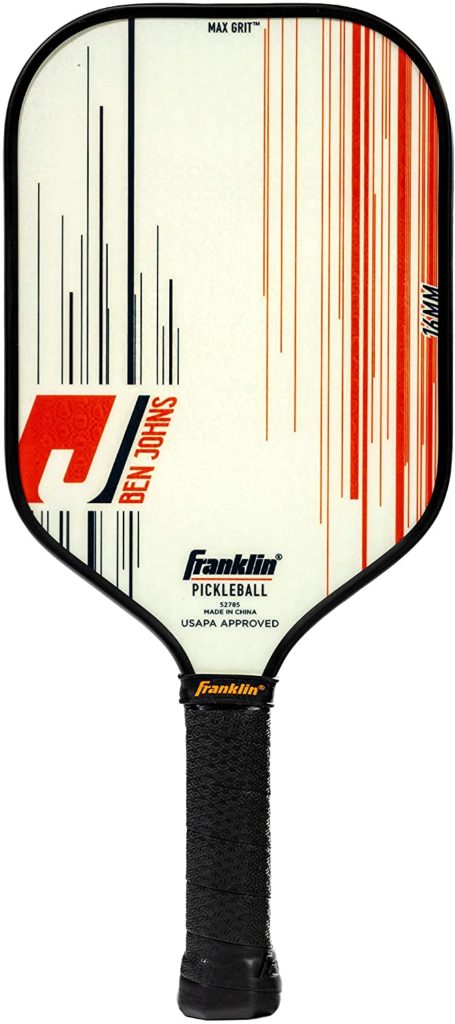
Franklin Ben Johns Signature Series 16mm
Let’s start with the Ben Johns Signature Series Franklin 16mm (0.62” inches) Paddle. In recent months, this paddle has exploded in popularity due to Ben Johns’ complete dominance in the sport. The thought process is that if the greatest pickleball player uses this paddle, it must be good!
That’s not how things work in the real world, but the marketing team over at Franklin is giddy with excitement that you think its paddle will help you play like Ben Johns. At 16mm, this paddle is thick. Franklin states the extra thickness creates softness and helps the ball stay on the paddle longer, therefore creating better touch and more forgiveness. At 16mm, this paddle should have a large “sweet spot” and Biblical forgiveness.
Time out!
What is the “sweet spot” you might ask? Good question, because there is little scientific information on this buzzword that companies throw around. From what I can gather, the sweet spot of a paddle is where the ball ricochets off with maximum power and has the cleanest direction. Hitting any spot outside the sweet spot changes the trajectory of the ball and takes away some of the potential velocity from the ball. That’s why if you hit a ball outside the sweet spot, you may notice an erratic shot, whether slower speed or misdirection.
Ok, back to the review.
Since Ben Johns uses a soft paddle, he compensates by generating more power. At least that’s the theory. Upon first arrival, I noticed the paddle seemed thick, but unusually light and flimsy. To be honest, my first impression was that Mr. Johns’ paddle was cheap. At the time, I was using a Paddletek Bantam EX-L Pro, which is similarly thick, but also slightly heavier and felt more stout.
Warming up with the Franklin paddle, I thought I had traded my manly, muscular arm for a wet noodle. On the first pop-up from my opponent, I smashed the ball with the strength of a 9 year old piano-playing child. If memory serves correctly, my elderly opponents returned that smash without blinking. One player in the room yelled out, “I think we found your new paddle!”
So far, I was less impressed with the performance of Benny’s paddle than my rivals. As I shamefully walked over to my bag to hide the Franklin paddle forevermore from my sight, the room exploded in protest. Several gentlemen begged me to use it longer under the guise that I didn’t give it a fair shot and needed at least a week of testing to know its true abilities.
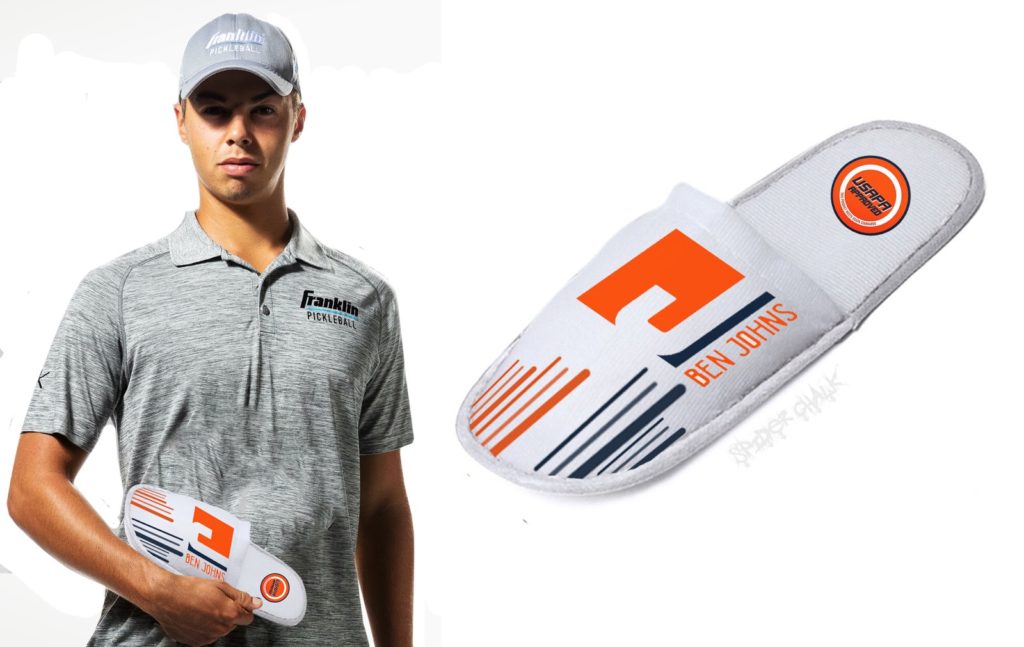
Have you seen the video of Ben Johns playing pickleball with a slipper? (Skip ahead to 23 minutes). I realized he’d been winning with a slipper for most of his career.
RATING: 2 out of 10. Cheap, flimsy, no power.
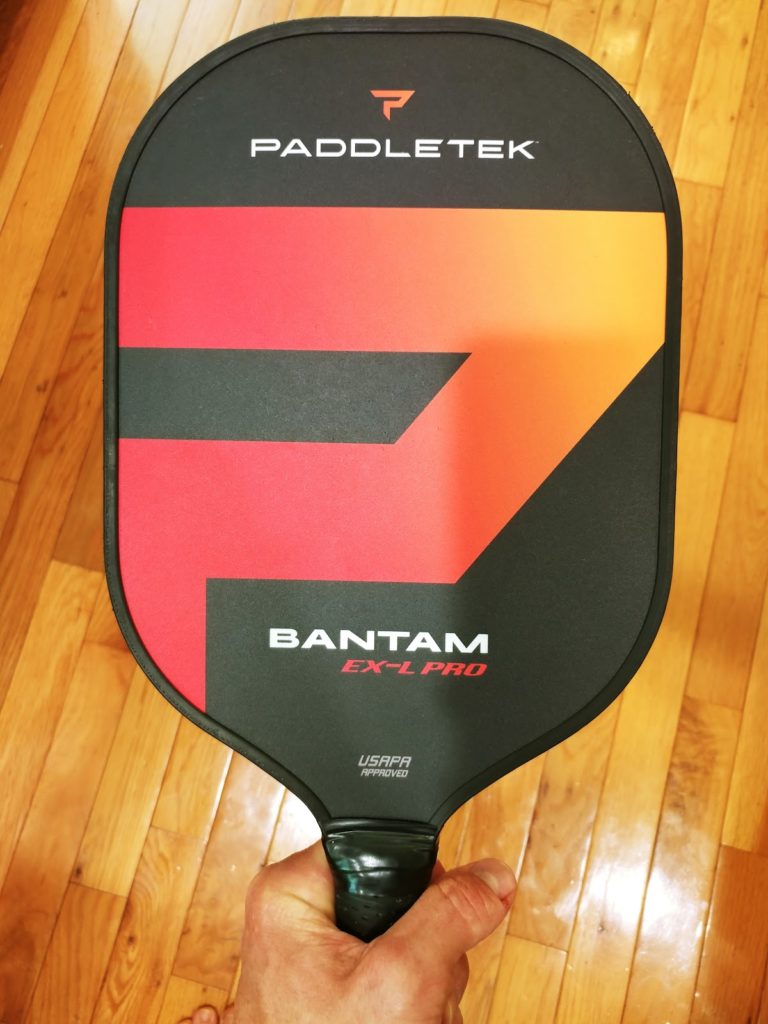
Paddletek Bantam EX-L Pro
Paddletek makes polycore paddles here in the USA and is one of the largest paddle makers. The company also private labels Prince paddles and a few other lesser-known brands. Its customer service is either very non-responsive or the employees read my last paddle review and were offended. Either way, I’ve emailed them several times with no response.
I began playing with the Paddletek Bantam EX-L Pro because my Gearbox GX6 wasn’t hitting 3rd shot drops with the touch and precision I required. My arm was obviously hitting the perfect shots and the paddle was clearly messing it up, so I began testing polycore paddles to see if they would help.
The Bantam is Paddletek’s power paddle. The handle on the Bantam EX-L Pro is short and stubby giving you an extra large face and a very large sweet spot. If you miss the center of the paddle, you still get a strong shot.
I was immediately drawn to the extra precision of the Bantam and the softer feel when compared to my Gearbox GX6. I made some amazing slams on pop-ups, while consequently dropping my opponents to death in the backhand corner. My doubles partner was excited with my newly improved playing ability and could finally stop covering both his side and mine.
After a few games, we concluded with a final match that lasted 45 minutes against some of the best players around. In that game, I hit nasty top spin shots, received yummy pop-ups in return and dinked like Anna Leigh Waters with sore hands. Maybe these plastic core paddles aren’t so bad once you get used to them!
The short handle length—comparable to Tyson McGuffin’s shorts (4.5 inches)—was my only complaint. And for those playing with a short handle, you know the importance of proper length! Thankfully, I also had the Tempest Wave Pro with proper sizing to test out next.
Rating: 8 out of 10. -1 for small handle. -1 for elbow tendonitis. +8 for lots of power, good touch, large sweet spot, good forgiveness.
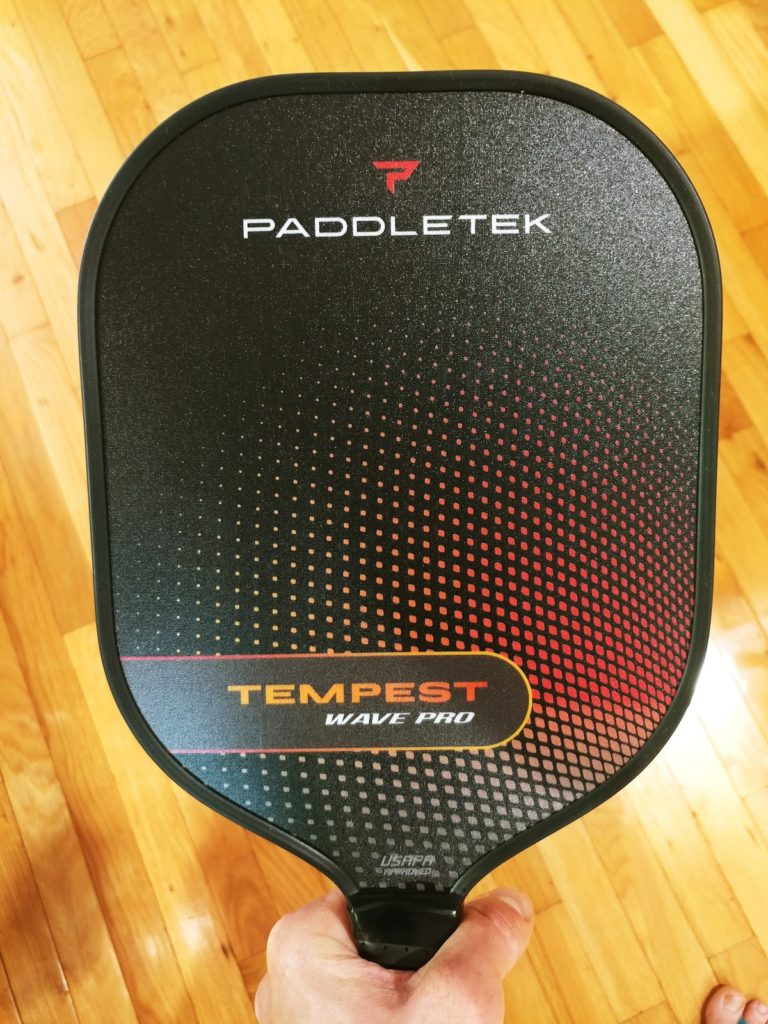
Paddletek Tempest Wave Pro
Paddletek’s premier paddle is the Tempest Wave Pro because it offers the highest level of touch, best precision and most forgiveness. I purchased the $180 Wave Pro in hopes that I would skyrocket to the Pro Tour and beat Simone Jardin in singles.
Transitioning to the Wave from the Bantam was easy as they are quite similar. Having a longer handle allowed me to focus more on the game without the distraction of the grip.
After several games, I noticed a softer level of play. Either I was tired from my CrossFit workout a few days before, my arms had atrophied or this paddle didn’t hit as hard as the Bantam. Miss-hits outside the sweet spot went soft and squirted off lazily.
I was, however, able to land more drop shots than ever before! But inside play made the ball bounce high enough for a strong return and outside hitting into wind was yanking my arm off on drives. This led me to return to the Bantam for that extra power I needed.
My partner plays exclusively with the Wave Pro, but he’s an ex-college baseball player who hits the ball like it insulted his wife. Because I’m more of a precision player with less power, I rely on the paddle to compensate. The Wave Pro was my paddle for many wins and several losses, but ultimately, this was not the best paddle for my style of play.
The Wave Pro is an excellent paddle and I see why Paddletek charges a mortgage payment for this model. For $100, I would absolutely keep this in my bag. Send me a discount code, Paddletek, and this baby goes back into the quiver.
Rating 8 out of 10. -2 for lack of power. +8 for forgiveness, touch, handle length.
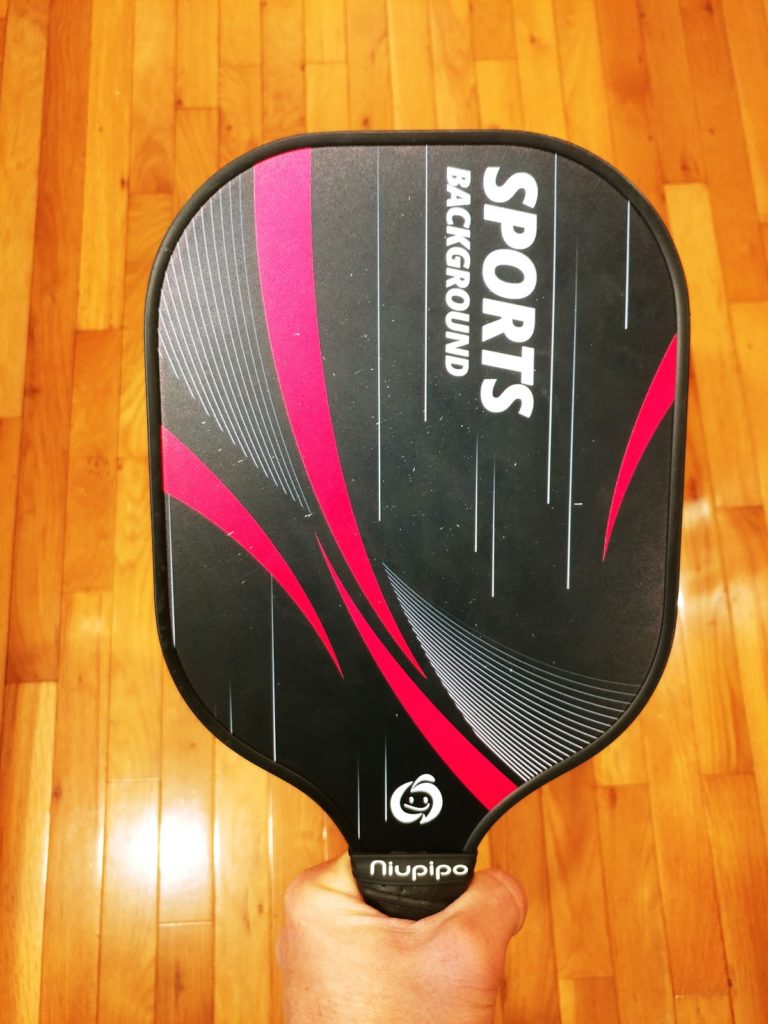
Nuipipo Nomex Core
Nuipipo sent me this paddle for free as it was an Amazon return from a previous customer. It is supposedly a nomex core, but my previous review of the Gamma Atomic 2.0 tells me that this either isn’t a true nomex core or they did something wrong in the manufacturing process.
Nomex cores are the easiest to identify since they have a loud POP sound when you hit the ball. This paddle has a soft, dull sound similar to polycore paddles. Also, it hits like a thin-core poly paddle. Thinner-core poly paddles hit harder than thicker core paddles, but they are less forgiving and tend to torque or twist in your hand if you don’t hit the center of the sweet spot.
After 5 minutes of warm-up, I passed it over to my 9-year-old son, who loved it immediately. He considers dinking a woman’s sport, plays mostly singles and this Nuipipo paddle has been his training paddle now for several weeks.
Rating: 4 out of 10. +4 for being higher-quality than Ben Johns paddle, but better than other paddles from China. -6 for mediocre power, touch, precision, etc.
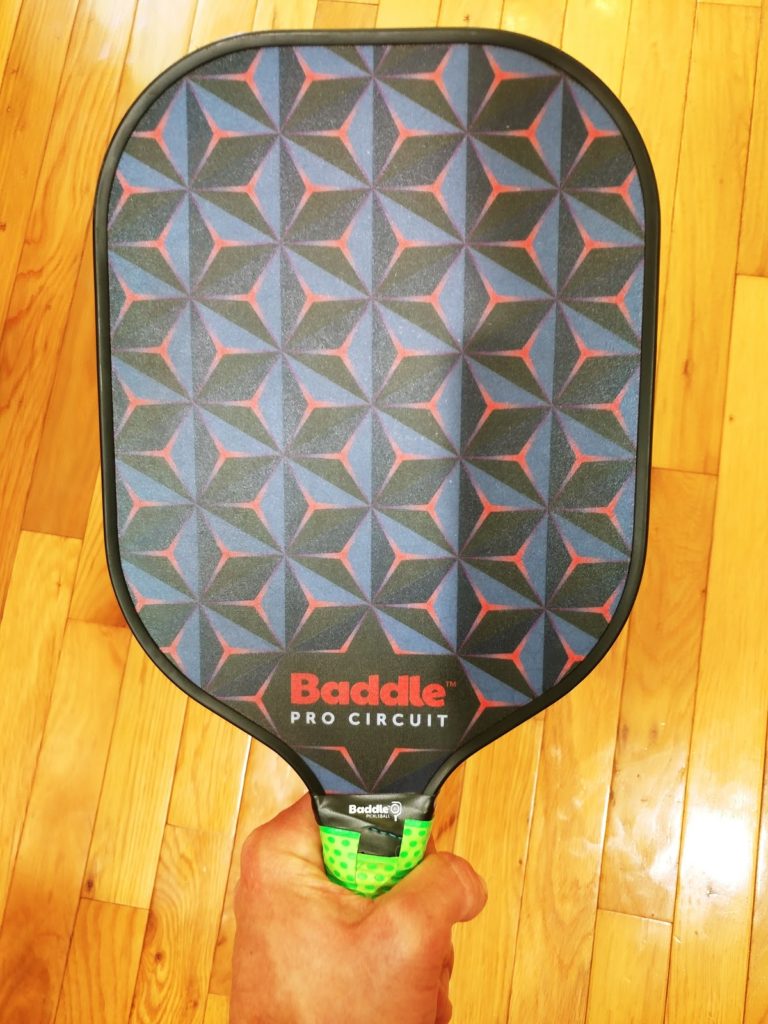
Baddle Pro Circuit
Baddle is a newcomer to the pickleball paddle industry and manufactures its paddles in China. I was curious to see if its paddles were the same as the hundreds of Chinese-made paddles available on Amazon for $40. I tested the Baddle Pro Circuit and Baddle’s lime green outdoor balls.
The Pro Circuit is very thick. This is unusual because all of the Chinese-made polycore paddles I’ve tested are thin. Then I noticed the crazy weave texture of the paddle face. And it had a long handle. Ok, Baddle, you got me interested.
Admittedly, my expectations were low because I own a company that manufactures in the USA and my experience with Chinese-made items, without exception, has been terrible. The day I received the Pro Circuit, I played both outdoor singles and outdoor doubles matches. In both matches, my serve was popping off like it was on fire. I was ripping chainsaw serves and hitting 3rd shot drives that should’ve come with a warning! My wife has the most dangerous backhand in the Deep South. But with the amount of spin I was generating, she was either testing the edges of her paddle or thought the sweet spot was located in the handle!
Next, we played a game of skinny-singles where you hit into one side of the court only. I immediately dialed in my drop shot and started cross-court dinks. Like my son, I have very little patience for dinks. I don’t lift heavy weights to tap a whiffle ball for minutes at a time. But suddenly, I’m in long dink rallies and actually enjoying it.
Alright, so I had one good day. Everyone has a good day eventually, right?
The following day I played against my 4.0+ friends, who have a complete toolbelt of shots. They like to pick you apart and exploit your weaknesses. After playing with the Bantam and the Wave Pro for several weeks, I was focused on making smart, precise shots instead of hitting hard and getting it slammed back into my face.
The Pro Circuit was surprisingly good at placing the ball with adequate power and I was hitting more tough shots than normal. On one particularly juicy pop-up, I swung like I was ripping off my arm and yelled, “Call your dentist!” as I slammed the ball into the concrete and my opponents scattered like roaches in the light.
My improved skill didn’t go unnoticed by players who practice four times a week for hours each day and consider pickleball a full-time job. Here’s this kid who only plays a couple hours a week and he’s suddenly hitting winners! Some people say they play for fun; some people for the competition. But the look of frustration on their faces is why I continue to show up.
All seriousness aside, the Baddle Pro Circuit may be the hardest paddle to clearly explain. It hits harder than the Wave Pro and has better precision and more forgiveness than the Bantam. It has a longer handle than the Bantam and more spin than either the Wave Pro or the Bantam. It has better control than the Gearbox GX6 and a larger sweet spot, too.
Since testing the Pro Circuit, I’ve occasionally switched back to my Paddletek, Gamma and Gearbox paddles, but I always return to the Baddle Pro Circuit when I want to dominate. For my style of play and at my current skill level, this is the most well-rounded paddle in my bag.
Rating: 9 out of 10. Would have earned a 10, but it’s made in communist China so -1.
Paddle Roundup and Ratings
After testing nearly a dozen paddles (see my first paddle post) with four different cores, what are my overall thoughts on the best pickleball paddles? Polypropylene core paddles are the best core for most players since they are adequate at both power and control. But nomex, carbon fiber and aluminum cores are necessary for certain players.
Also, the higher the skill level of the player, the less the paddle matters. A 4.0+ player can use several different paddles from various brands with effectiveness, while a 3.5 player or lower should stick with a single paddle until they become more skillful.
Here are my ratings of the 6 best pickleball paddles and my subjective thoughts on control, power and forgiveness.
- Baddle Pro Circuit (excellent control and power, good forgiveness)
- Paddletek Bantam EX-L Pro (good power, adequate control, good forgiveness)
- Paddletek Tempest Wave Pro (excellent control, excellent forgiveness, adequate power)
- Gamma Atomic 2.0 (excellent power, adequate control, adequate forgiveness)
- Selkirk 300A XL (excellent control, adequate power, adequate forgiveness)
- Gearbox GX6 & GX5 (adequate control and adequate power, little forgiveness)

Great, Thanks for sharing
Welcome to The Big Dink! We’re a family-run business that’s passionate about pickleball. But we’re not just a bunch of stuffy corporate types – we’re real people with a love for the game and a desire to bring a little bit of fun and personality to the pickleball world.
thanks for sharing, mate